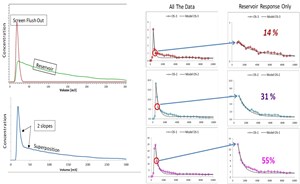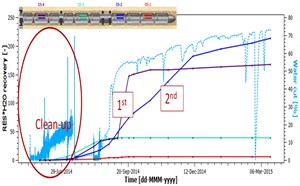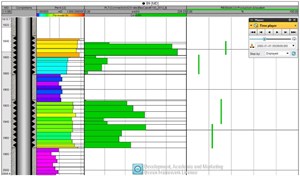Resman improves production optimization with long-life tracer systems
STAVANGER -- As production optimization depends on accurate, decision-making well and reservoir data, data collection and planning techniques have become increasingly important.
At ONS this year, Norwegian company Resman AS will be highlighting its innovative tracer technology and how it is delivering zone-specific well production data and production trends for use in production optimization and continuous well performance evaluation.
The company is also developing a real-time inflow tracer technology system which will allow operators to obtain quantified zone-specific production rates during full production, with tracer signals obtained directly from the flowing well stream. It is innovations such as this that have led to Resman being nominated by the Norwegian Petroleum Directorate (NPD) for its 2018 IOR prize. The IOR prize, handed out at ONS each year, focuses on ground-breaking work related to improved oil recovery.
How chemical tracing works?
Polymer rods containing chemical tracers are typically installed in the completion in the different zones of the well. When the permanent tracers are contacted by target fluid, they will selectively release based on fluid contact.
The traditional method of interpretation for the inflow tracers is based on the quantification of transient flow, where the well is shut-in, a cloud of tracers is built up in the individual well zones, and then flushed-out when the well is opened. By analyzing the arrival pattern of tracers on the surface and tracer concentration decay during the start-up, it is possible to determine both qualitatively and quantitatively where production is coming from. Such data also provides important information with respect to well clean up, the efficiency of different well completions, economics in extended reach wells and well paths, and the identification of early problems such as water ingress.
However, with longer lifetime on systems--currently up to 10 yrs--a new use of the systems is opening up, with very low incremental cost to the operator. This is achieved through continuous monitoring of zonal well performance trends during production.
With the company’s well monitoring technology, small amounts of tracers are released continuously, and by analyzing samples taken from the well over a period of time (e.g. over two months with one sample taken every week) it is possible to correlate trends in zone-specific tracer concentration with trends and changes in production behaviour for the well. This can be related to oil/water/gas production rates, water cuts, gas-oil ratios, bottom hole/tubing head pressure/temperature and sand production.
Consequently, the tracers add a zonal resolution to the well production data for targeted well performance assessment and operational decisions. For instance, if the water cut suddenly increases, an increase in tracer signal from one of the zones will indicate from where and when the increased water comes from and what zone to keep under observation and consideration e.g. a targeted water shut-off operation. Similarly, sudden drop in oil tracer signals can be used to identify targets for zone-specific stimulation to increase oil production from these zones. To expand the scope of fluid-specific information, Resman has also undertaken development to gas inflow tracers and is also currently testing this technology in producing wells.
In order to offer its clients a full suite of solutions, Resman is developing a real-time tracer system, which releases a tracer cloud to deliver quantitative zonal contribution profiles during normal well production.
Other production optimization benefits
Operators use the inflow tracers to determine if the different zones are producing after initial start-up and to assess if the well has been properly cleaned up. The inflow tracers can also be very useful when testing different well designs or longer well paths to determine the relative production from a lateral or extended toe in the well (based on the transient flow model).
Additional value can also be captured from steady state data over time by collecting well samples during full production and looking for changing production trends coming from each zone. The individual samples may vary significantly, but over time one can typically detect distinct patterns and trends when correlated to other production data.
Importantly, zone-specific well performance at different operational settings can be evaluated. Analyzing tracer profile changes during a multi-rate test, where changes of the well are intentionally induced by the operator, can give important insight and decision-support for production optimization. If the choke is reduced, the drawdown and production rate is reduced and from tracer profiles it will be possible to see if, for example, tracers from specific zones disappear. This would indicate that this zone requires higher drawdown and hence provides information about differential pressure distribution along the wellbore. Conducting a controlled multi-rate test and correlating production changes with tracers signals will provide the operator with essential information about the operational modes of the well and can be used for future production optimization.
For history matching of reservoir models, it may be desirable to have accurate steady state flowrates. As such, both tracers and Production Logging Tools (PLT) are an approximation for what the reservoir engineer requires for a perfect history match. A multi-phase meter and steady state tracer trend data, coupled with the general understanding of the reservoir and well path, should in most cases be sufficient to locate a problem under development and determine where and when the problem occurred.
Conclusions
The powerful concept of continuous monitoring, where tracer signal trends are cross-correlated with general production data, is directly compatible with already existing data workflows used for production optimization and reservoir surveillance. In this way, value can be extracted when tracer data is uploaded into the operator’s existing database system and software platforms. To this end, RESMAN has developed software to import the data into Petrel and Roxar RMS reservoir modelling software.
To find out more about how you can monitor your reservoir for up to 10 years with no intervention, please visit the Resman booth at ONS 2018 in Hall 2, Midnor stand 2400.





